Iolite from the Thor-Odin Dome, British Columbia, Canada: Geology, Chemical Composition, Inclusions, and Cause of Chatoyancy

ABSTRACT
The Blue Arrow and Blue Bear iolite (gem cordierite) claims located in the Thor-Odin dome (near Revelstoke in British Columbia, Canada) are two new examples of iolite occurrences hosted in hydrothermally altered mafic volcanic rocks metamorphosed at upper amphibolite to granulite facies, in which cordierite (XMg = 0.81–0.90) occurs in association with gedrite, iron-rich phlogopite, quartz, almandine-pyrope garnet, and various trace minerals. Strongly pleochroic, gem-quality cordierite rough from these claims produced dark violet-blue faceted stones generally smaller than 2 ct (both localities) and light grayish blue to dark slightly grayish violet-blue chatoyant cabochons up to approximately 12 ct (Blue Bear only). Coarse-grained cordierite-rich rocks are widespread in the Thor-Odin dome, which indicates good potential for future iolite discoveries in the region. Primary mineral inclusions in Blue Bear iolite include iron-rich phlogopite, muscovite, zircon, xenotime-(Y), hematite, and apatite. Where cordierite is traversed by rehealed fractures, mica inclusions are altered to unidentified hydrous aluminosilicates rarely containing trace pyrrhotite or barite. Three types of fluid inclusions occur in Thor-Odin iolite: (1) primary blocky fluid inclusions; (2) primary acicular fluid inclusions oriented parallel to the a-axis of cordierite, which cause chatoyancy when present in high concentrations (at Blue Bear only); and (3) secondary subequant fluid inclusions occurring along rehealed subconchoidal fractures.
Two gem-quality cordierite (iolite) localities, the Blue Arrow and Blue Bear occurrences, were recently discovered (in 2016 and 2021, respectively) in the mountainous Thor-Odin dome, southwest of Revelstoke in British Columbia, Canada (figure 1). They have so far produced small quantities of faceted stones (generally <2 ct, though the author has seen faceted windowed stones up to 4.76 ct from Blue Bear) and attractive cat’s-eye cabochons (up to 12.02 ct, Blue Bear only). The present study seeks to gain new insights into: (1) the geological origin of the occurrences in a regional context and how they compare to the geology of other iolite deposits, (2) the nature of iolite mineralization at the Blue Arrow and Blue Bear localities, (3) the chemical composition and inclusions of Thor-Odin dome iolite, and (4) the nature of the inclusions responsible for chatoyancy.
GEOLOGY OF IOLITE DEPOSITS
Deposits of iolite (gem-quality cordierite) occur in magnesium- and aluminum-rich metamorphic rocks formed at amphibolite to granulite facies conditions. Many iolite occurrences are found around the world, but relatively few have been comprehensively characterized from a geological (i.e., petrological, geochemical, and geochronological) perspective.
Significant deposits occur in the Bandarguha and Orabahala areas of Kalahandi District, India, where gem cordierite (with XMg = [Mg]/[Mg + Fe] = 0.82–0.88) is hosted in granulite facies cordierite-biotite schists and gneisses, which can contain the following accessory minerals: quartz, potassium feldspar, plagioclase, sillimanite, corundum, and orthopyroxene (Das and Mohanty, 2017).
At the Geco copper-zinc mine—a volcanogenic massive sulfide deposit in Manitouwadge, Ontario, Canada—cordierite (XMg ≈ 0.80; Fox and Yakymchuk, 2017) occurs in amphibolite facies (650° ± 30°C, 6 ± 1 kbar; Petersen, 1984) rocks consisting of a metamorphosed hydrothermally altered (calcium- and sodium-depleted) basalt and a cordierite-rich dike possibly representing an altered synvolcanic dike (Pan and Fleet, 1995). The typical cordierite host rock at the Geco mine is a cordierite-gedrite gneiss often containing quartz, sulfides (generally chalcopyrite), and garnet; but it is also found in quartz-rich segregations (Pan and Fleet, 1995; P. Belley, hand sample observations). The Geco mine is a significant iolite occurrence that did not produce much gem rough due to the exclusive focus on copper and zinc mining (B. Wilson, pers. comm., 2018). Wilson (2014) noted beautiful violet-blue faceted stones of 2.00 and 2.20 ct from the Geco deposit, as well as an overly dark 6.10 ct stone.
Gem cordierite occurs in magnesium- and aluminum-rich, orthoamphibole-bearing rocks (similar to those at the Geco mine but not associated with sulfide deposits) at Palmer Canyon in the Laramie Range of Wyoming, United States (Patel et al., 1999; Hausel, 2002), and in the Passmore area, Shuswap metamorphic complex, southern British Columbia (Simandl et al., 2000). In the Passmore area, the gem cordierite mineralization occurs in contact metasomatic deposits that are in contact with anthophyllite-rich granulite facies metamorphic rocks (1) between more siliceous intrusive or crosscutting rocks such as quartz veins and pegmatites and (2) in biotite-rich rocks (Simandl et al., 2000).
HISTORY AND ACCESSIBILITY
While gem-quality cordierite was not discovered in the Thor-Odin dome until 2016, it has been known to occur in a nearby geological terrane, the Valhalla metamorphic core complex, since the 1990s. In 1998, exploration near Passmore in British Columbia (within the Valhalla complex) by Anglo Swiss Resources Inc. generated about 50 kg of high-grade rough iolite, which yielded less than 100 carats of finished gems (Wight, 1999; Laird, 2002). Passmore produced both “bright and lively [faceted stones] with a blue-violet color and excellent clarity” up to 0.6 ct (Simandl et al., 2000; Wilson, 2014) and cabochons up to 1.5 ct (Simandl et al., 2000), some of which display asterism (Wight, 1999).
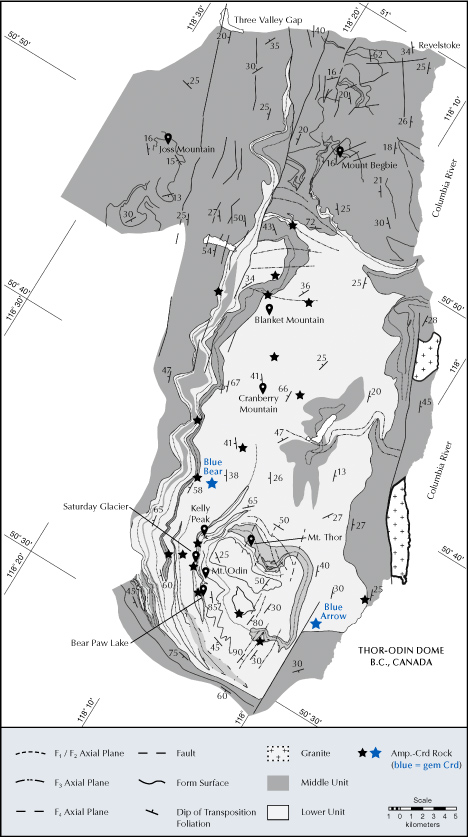
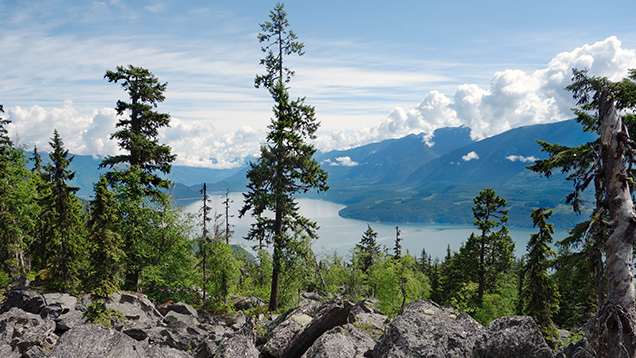
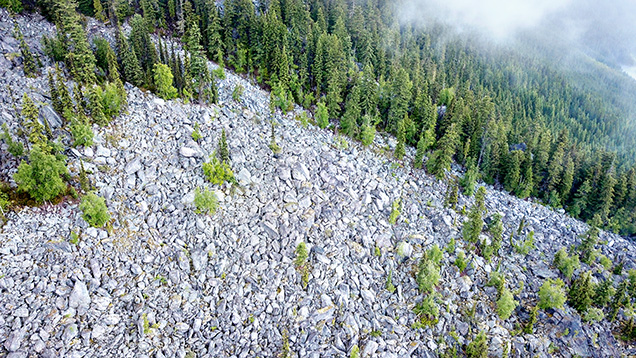
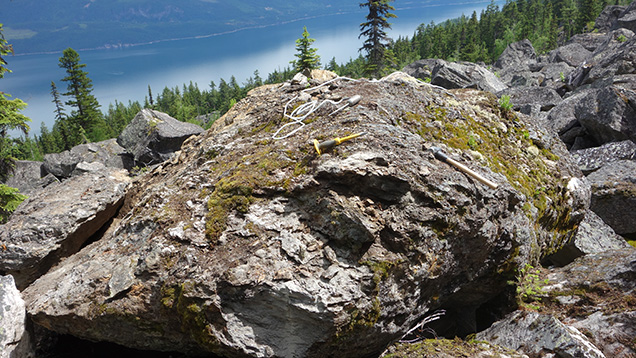
Cordierite-orthoamphibole rocks have been documented from 20 localities within the Thor-Odin dome (Duncan, 1984; Norlander et al., 2002; Hinchey and Carr, 2007; Goergen and Whitney, 2012; see figure 2 of the present study), although as many as 30 cordierite localities are known to local prospectors (H. Hyder, pers. comm., 2022). In 2016, prospector Herb Hyder discovered the Blue Arrow iolite occurrence in talus overlooking Arrow Lake (figures 3 and 4), and in 2021 he discovered the Blue Bear iolite occurrence (currently under claim) in outcrop at high elevation (approximately 2000–2400 m above mean sea level) 1–2 km south of Dickinson Lake and west of Horsefly Peak. The iolite occurrences are located on relatively steep slopes (see figures 4 and 5) and very difficult terrain. Both localities can be accessed by hiking from the nearest logging road, but the Blue Bear claim is most easily accessed via helicopter since it is a substantially difficult hike with considerable elevation gain. Due to its high elevation, the Blue Bear locality is covered by snow except for one or two summer months (generally in August). At the time of this writing, collecting is not permitted at either claim and the mineral exploration rights are privately owned.
GEOLOGICAL SETTING
Regional Geology. The study area is located in the Thor-Odin dome, which forms the southern portion of the Monashee complex—the deepest structural level of the Shuswap metamorphic core complex in the Omineca Belt of southern British Columbia. The Thor-Odin dome consists of Paleoproterozoic basement rocks (primarily migmatitic paragneiss and orthogneiss) and Paleoproterozoic to possibly Paleozoic supracrustal metasedimentary cover rocks, both of which experienced high-grade (granulite facies; 750°–800°C) metamorphism concomitant with decompression from above 8–10 kbar to below 5 kbar during exhumation, resulting in anatexis.1 Partial melting occurred approximately 60 to 54 Ma, possibly continuing until 51 Ma (Vanderhaeghe et al., 1999; Norlander et al., 2002; Hinchey et al., 2006).
Cordierite-bearing gedrite-rich gneisses occur at regional scale and exclusively within the paragneiss in the basement sequence of the Thor-Odin dome (the “Lower Unit,” also containing orthogneiss), which consists mostly of cordierite-biotite-quartz-feldspar gneiss, migmatitic garnet-sillimanite-quartz-feldspar gneiss, with local calc-silicate rock, marble, and quartzite (Norlander et al., 2002; Hinchey and Carr, 2007). The only previously reported gem materials found within the basement sequence of the Thor-Odin dome are large crystals, averaging 5 cm across and up to 10 cm, of opaque to rarely translucent, internally fractured, zoned dark blue and dark grayish brown corundum (the latter being star sapphire). These corundum are reported from a single locality, where they occur within restite boudins2 in leucosome3 of metapelitic4 origin, having formed as a result of muscovite breakdown and partial melting along the prograde P-T path at or before 60 Ma, near peak granulite facies metamorphic conditions (Abdale et al., 2023).
1Anatexis: The partial melting of crustal rocks.
2Restite: Residual material left at the site of partial melting, such as in a migmatite. Boudin: A sausage-like pinch-and-swell structure formed by extension of originally continuous rock layers.
3Leucosome: The light-colored portion of migmatite, which is a product of partial melting.
4Metapelitic: Sourced from or related to metapelites (metamorphosed pelitic rock such as shale or mudstone).
Gedrite-Cordierite Rocks. Gedrite-cordierite-rich rocks are widespread in the Thor-Odin dome (Goergen and Whitney, 2012; figure 2), where they occur as elongated boudins up to 500 m in length (Norlander et al., 2002). Two variants of this rock are known: one containing almandine-pyrope garnet porphyroblasts5 averaging 5 cm across and another containing sapphirine (Norlander et al., 2002). The mineral assemblage is variable but always includes gedrite (2–25 cm long and the most abundant mineral, comprising >30–40% of the rock), cordierite (usually as interstitial masses between gedrite blades), and biotite (phlogopite, with XMg ≈ 0.8). Other minerals observed in rock samples include garnet (up to 15 cm in diameter, where present), quartz, sillimanite, kyanite, sapphirine, corundum, and/or staurolite. Minerals occurring in trace amounts include ilmenite, rutile, apatite, magnesium-rich hercynite, plagioclase, and monazite (Norlander et al., 2002; Hinchey and Carr, 2007).
Gedrite-cordierite rocks in the Thor-Odin dome have a distinctive bulk chemical composition that is characterized by a relative depletion in alkali elements, calcium, and low field strength minor and trace elements, along with enrichment in aluminum, magnesium, iron, and high field strength trace elements. The rocks are interpreted to consist of Paleoproterozoic mafic volcanic rocks that underwent hydrothermal alteration, likely by seawater, and were subsequently metamorphosed in the Cordilleran orogeny (Hinchey and Carr, 2007). Hinchey and Carr’s genetic model is based on a combination of whole rock major and trace element chemical composition (including rare earth element patterns) and neodymium isotopic systematics.
5Porphyroblast: In metamorphic rocks, a larger mineral grain that occurs in a groundmass composed of relatively smaller grains.
DESCRIPTION OF THE IOLITE OCCURRENCES
Blue Arrow Occurrence. Violet-blue, strongly pleochroic cordierite occurs in approximately half a dozen large boulders (up to 2.5 m across; figure 5) on the northern side of an east-facing talus overlooking Arrow Lake. The talus measures approximately 1.0 by 0.7 km. The cordierite host rock consists of very coarse-grained (average 1–4 cm grain size) gedrite-rich gneiss consisting of the following minerals in rock-forming amounts (highest to lowest abundance): gedrite, anhedral cordierite (often occurring in the interstices of gedrite crystals), biotite, subhedral garnet porphyroblasts, and quartz. The cordierite occurs as translucent to transparent, dark blue masses up to approximately 8 cm. Cordierite porphyroblasts are highly fractured, with facetable gem rough that could produce finished stones 0.5 ct or larger coming only from small zones in a minority of the porphyroblasts.
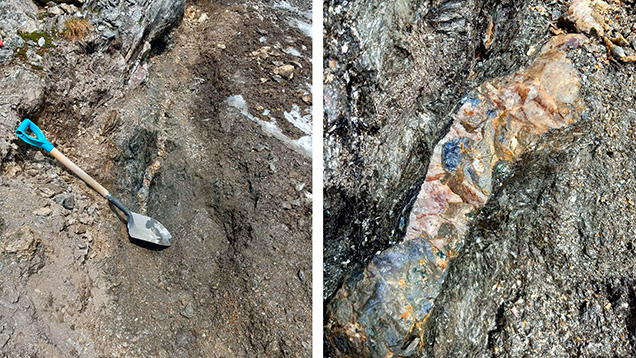
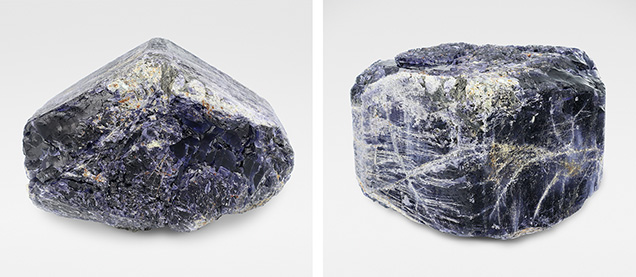
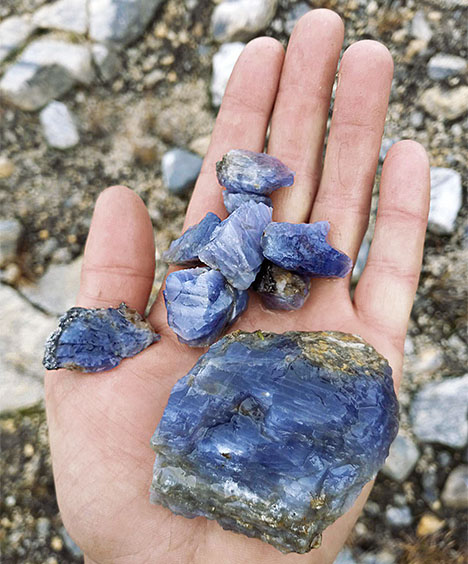

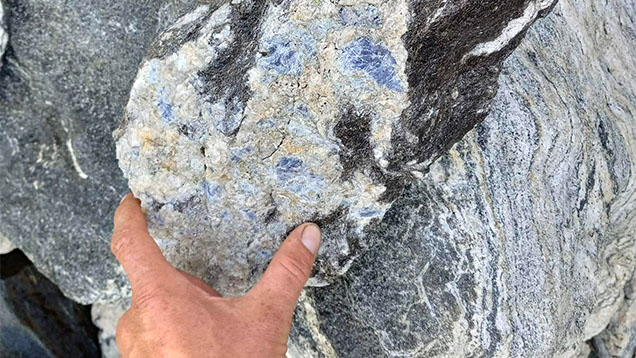
Blue Bear Occurrence. Violet-blue, strongly pleochroic cordierite occurs as subhedral to euhedral porphyroblasts in gedrite-cordierite-biotite-(±quartz) gneiss, and in quartz-cordierite veins (<10 cm thick) cutting these rocks (figure 6). The geographic extent of cordierite mineralization is currently unknown, and exploration in this steep, high-elevation terrain is ongoing. Cordierite crystals shown to the author averaged 5 cm across, and the largest crystal measured 11.3 cm long (figure 7). Cordierite crystals vary from anhedral to euhedral. Most large euhedral crystals are enveloped by biotite. The cordierite is highly fractured, translucent to transparent, and locally contains zones suitable for production of polished gemstones. Higher-quality material is shown in figures 7 and 8, and representative cordierite, quartz, and gedrite are shown in figure 9. In some crystals (in part or in whole), the cordierite is moderately to heavily included by parallel acicular inclusions. Cordierite that is not of gem quality occurs in biotite-rich quartzofeldspathic gneiss in the area (figure 10).
MATERIALS AND METHODS
Samples. The cordierite samples examined consist of ~4 kg of unprocessed rough from the Blue Bear claim and ~100 g from the Blue Arrow claim, both provided by Herb Hyder, an independent prospector. A 1.15 ct faceted stone from Blue Arrow was acquired from local gem cutter Russell Crick, who visited the locality. Additional samples were recovered by D.J. Lake and the author on a site visit to the Blue Arrow locality; however, none of this material was of sufficient quality to facet into stones larger than 0.3 ct. Rough samples provided by Herb Hyder were processed by the author, and the highest-quality material was sent for cutting and polishing, resulting in the production of faceted stones. The largest stones described in this study are a 1.15 ct faceted stone from Blue Arrow (figure 11), a 1.24 ct faceted stone from Blue Bear (figure 12), and chatoyant cabochons up to 12.02 ct from Blue Bear (figure 13). The largest faceted gemstones reported to the author from each locality consist of a very dark, included 2.0 ct stone from Blue Arrow and a dark 4.46 ct windowed stone from Blue Bear. The specific gravity of the largest stone of each variety and locality was obtained hydrostatically, and the refractive indices of Blue Arrow and Blue Bear faceted iolites were measured with a Kruss professional refractometer with a monochromatic sodium light source.
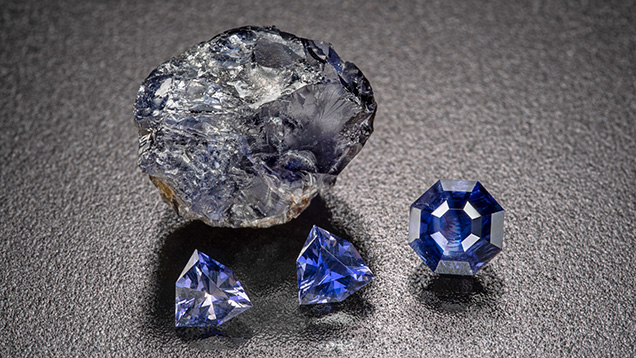
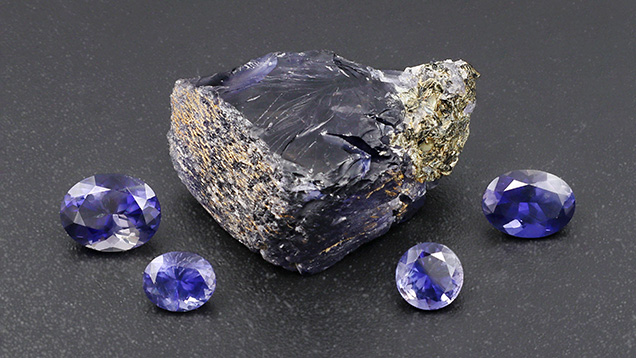
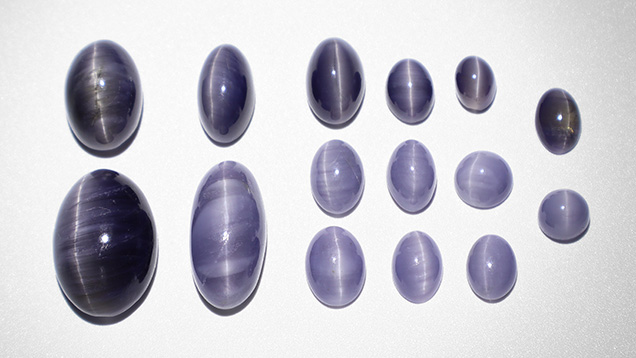
Sample Examination and Preparation. Rock samples were examined to characterize the mineralogy and mineral habits. Selected samples of individual minerals and rock fragments were polished into 25 mm sections, carbon coated (coating thickness 5–10 nm), and examined using Memorial University of Newfoundland’s FEI Quanta 650 SEG scanning electron microscope (SEM). The SEM was equipped with two Bruker XFlash 5030 energy-dispersive X-ray spectrometers (EDS) for mineral identification, with a 30 s X-ray acquisition time, and a secondary electron detector (SE) for acicular inclusion examination, using an operating voltage of 25 kV. Gem-quality rough was cut and polished (faceted stones and cabochons) and examined using a binocular gemological microscope.
Chemical Analysis. Five spots, each spread out over a ~1 cm2 area, were analyzed each on two representative gem-quality pieces from each locality. Chemical compositions of cordierite were obtained with a JEOL JXA-8230 electron microprobe at Memorial University of Newfoundland. Operating voltage was 15 kV with 20 nA beam current and 3 μm beam diameter. Count times were 40 s (except 20 s for sodium, potassium, and silicon, and 30 s for calcium) with background collection times equal to half of the count times. The following standards were used: orthoclase (potassium), albite (sodium), diopside (calcium, magnesium, and silicon), almandine (aluminum and iron), rhodonite (manganese), and sphalerite (zinc). Matrix correction calculations were done using the eponymous “PAP” method (Pouchou and Pichoir, 1985).
RESULTS
Properties of Rough. More than 90% of the cordierite at both Thor-Odin localities is not of gem quality, owing mostly to extensive post-formation fracturing, a common feature in metamorphic gem deposits, and less commonly owing to an abundance of primary mineral or secondary fluid inclusions. Gem-quality cordierite is present only in portions of single crystals, with a fairly random distribution, and the best gem rough generally comes from the largest crystals. The cordierite crystal in figure 7 illustrates deformation-controlled fracturing where the dominant fractures show some degree of preferential orientation. This crystal also contains facetable rough in an area where fracturing is less pervasive.
At the Blue Bear locality, cordierite contains a variable degree of parallel acicular inclusions ranging from nearly absent (not visible in a hand sample) to extremely abundant, often varying from both extremes within a single crystal. The portions richest in these inclusions are light slightly grayish blue and show strong chatoyancy (see the smaller rough fragments in figure 8).
Standard Gemological Properties. Cordierite from both localities is very strongly pleochroic, showing three different colors in different orientations: dark saturated violet-blue, medium-light blue-gray, and light gray-yellow with low color saturation. Specific gravity values for the three largest iolite gemstones from each locality and variety were 2.61 (Blue Arrow, faceted), 2.60 (Blue Bear, faceted), and 2.59 (Blue Bear, chatoyant cabochon). Refractive indices were measured on one faceted stone from each locality. These refractive index values were 1.610–1.620 for Blue Arrow and 1.538–1.548 for Blue Bear.
Properties of Cut Stones. Faceted Stones. When correctly oriented to maximize the violet-blue color, faceted iolite stones show a beautiful, saturated violet-blue color that is of medium lightness in stones in the half-carat range, while dark in stones of approximately 1 ct (figures 11 and 12). In similarly sized examples, faceted gems from Blue Arrow are darker than those from Blue Bear.
Cabochons. Cat’s-eye cabochon samples were from the Blue Bear locality only, and all of this material consists of translucent cordierite containing abundant parallel acicular inclusions. They were cut with the base perpendicular to the grayish yellow axis of the cordierite. The stones are therefore grayish yellow if backlit through the base. They display a distinct chatoyant band perpendicular to the long axis of the acicular inclusions (described below) that is visible even in diffuse indoor and outdoor lighting conditions. The cabochons occur in two color varieties: dark grayish blue-violet with a light gray cat’s-eye, and light gray-blue with a very light gray cat’s-eye (see figure 13). Darker cabochons contain a lesser amount of acicular inclusions and are more transparent than the lighter, more heavily included cabochons. The strength and sharpness of the cat’s-eye is identical in the dark and light varieties.

Chemical Composition. Gem cordierite from the Thor-Odin dome, which was analyzed using electron probe microanalysis (EPMA), is strongly cordierite-dominant, with only a minor component (<20 mol.%) of sekaninaite, the Fe2+ end member of the cordierite-sekaninaite solid solution series. The Blue Bear cordierite sample analyzed has a higher XMg value than the sample from Blue Arrow, with values of 0.90 and 0.81, respectively (table 1). The higher iron concentration in Blue Arrow cordierite correlates with a darker color in larger stones (compare figures 11 and 12). The analyzed sample of Blue Bear cordierite is richer in manganese, zinc, and sodium than the Blue Arrow cordierite sample.
Mineral Associations and Inclusions. At both localities, inclusions observed in rough crystals include millimeter- to centimeter-scale grains and clusters of biotite (likely iron-rich phlogopite), gedrite, and quartz. These minerals form a stable assemblage with cordierite in the gneiss. Muscovite occurs locally in Blue Bear gneiss and, based on grain boundary relationships, appears to form a stable assemblage with gedrite and cordierite. A 1.5 mm yellow hexagonal prismatic apatite crystal was observed in cordierite from Blue Bear.
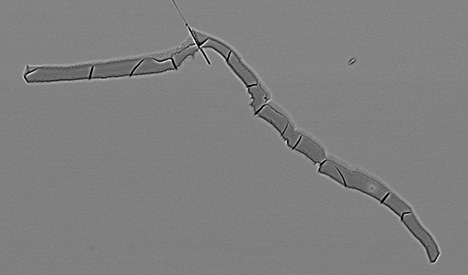
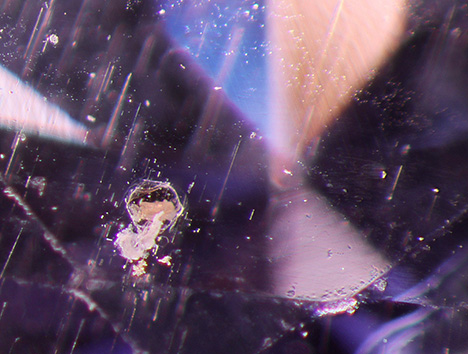
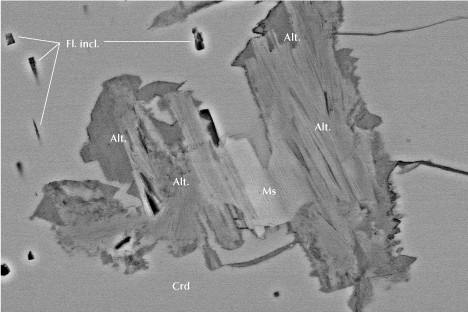
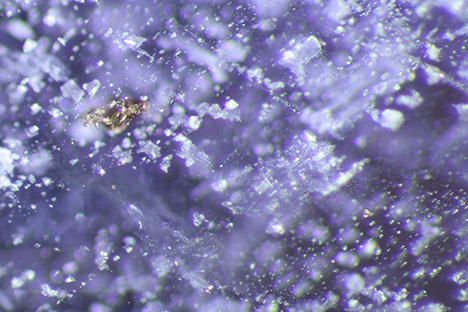
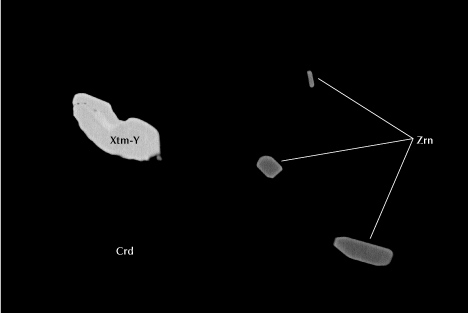
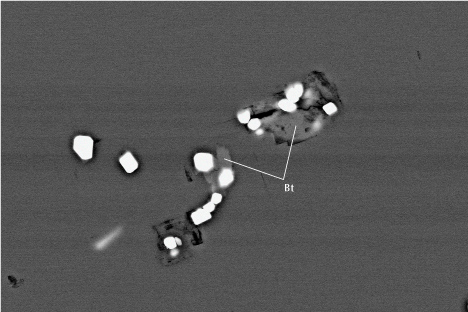
Rehealed fractures, indicated by the presence of secondary fluid inclusions along subconchoidal fractures, are common in iolite from the two localities. Relatively few gem-quality samples were available from Blue Arrow, so the following inclusion descriptions focus on Blue Bear iolite, where a combination of optical microscope and SEM-EDS was used to examine faceted stones and flat-polished samples. Some subconchoidal fractures in iolite are filled with a translucent white unidentified hydrous aluminosilicate phase containing equal molar proportions of aluminum and silicon, and 0.5–2.2 mol.% of iron, magnesium, calcium, and potassium (figure 14). This mineral may be impure halloysite, a common alteration mineral of cordierite (Layman, 1963). The most common inclusions observed in Blue Bear iolite are fluid inclusions (both primary blocky fluid inclusions and secondary subequant rounded inclusions along rehealed subconchoidal fractures), acicular inclusions (causing chatoyancy when abundant; described below), euhedral platy brown iron-rich phlogopite (figure 15), tabular to equant white muscovite (commonly altered to hydrous aluminosilicates containing aluminum and silicon in similar molar abundances, and possibly consisting of clay minerals; figures 16 and 17), zircon (figure 17), anhedral uranium-bearing xenotime-(Y) (figure 18), and platy hematite (≤20 μm crystals). Zircon is fairly common in cordierite as groupings of closely spaced, euhedral to subhedral, light-colored or colorless prismatic crystals associated with biotite (figures 17 and 19). The zircons appear yellowish due to the presence of radiation damage in cordierite proximal to these grains, making their true color difficult to assess. Partly to wholly altered muscovite and less commonly biotite, which are replaced by hydrous aluminosilicates, occur in close proximity to fluid inclusions that indicate the presence of rehealed fractures. Unaltered mica-species grains occur in areas not traversed by such features. This hydrous aluminosilicate alteration rarely contains very small (approximately 5–10 μm) inclusions of pyrrhotite or barite.


Chatoyancy-Causing Inclusions. Acicular inclusions are common in cordierite from the Blue Bear claim. They are less abundant in facetable material (figure 15) and more abundant (to the point of decreasing transparency) in chatoyant material. The inclusions are straight and oriented parallel to the direction of greatest light absorption in cordierite (the dark violet-blue axis). Even in single cabochons, these inclusions vary in concentration, forming bands of slightly higher or lower inclusion density (figure 20, left). The inclusions vary in length and, to a lesser degree, diameter (figures 15 and 20, right). A polished section of chatoyant cordierite, cut at an oblique angle to the acicular inclusions, was examined using SEM in secondary electron mode. This revealed that the exposed inclusions (≤2 μm in diameter) are hollow and thus do not consist of solid inclusions (figure 21).
DISCUSSION
Deposit Geology. The iolite occurrences in the Thor-Odin dome of British Columbia bear many resemblances to other deposits and occurrences worldwide: They all occur within, or contiguous to, upper amphibolite to granulite facies magnesium- and aluminum-rich metamorphic rocks. Cordierite-bearing rocks in the Thor-Odin dome, like those in most other localities, are associated with rock-forming amounts of orthoamphibole (gedrite, though some localities contain anthophyllite). These rocks differ from those reported in the Bandarguha and Orabahala areas of India, which are principally composed of cordierite and biotite (Das and Mohanty, 2017). Iolite localities that have been subject to more extensive petrological and geochemical research, such as Thor-Odin (Hinchey and Carr, 2007) and the Geco mine (Pan and Fleet, 1995) consist of alkali- and calcium-depleted, magnesium- and aluminum-enriched metamorphic rocks with hydrothermally altered mafic volcanic (i.e., basaltic) protoliths.
Gem cordierite mineralization at Blue Arrow is similar in habit to another locality in the Thor-Odin dome, where cordierite occurs as anhedral crystals in the interstices of large gedrite crystals (Hinchey and Carr, 2007). While the Blue Bear locality occurs in a comparable geological setting—cordierite-gedrite rocks—the nature of the mineralization differs from that at Blue Arrow: Cordierite crystals are anhedral to euhedral and occur both within the gedrite-rich rock (where they are sometimes enveloped by a layer of biotite) and in quartz veins cutting this rock. The occurrence of cordierite within crosscutting quartz segregations is reported from the Thor-Odin dome for the first time in the present study, but similar mineralization is known at the nearby localities in Passmore, British Columbia (Simandl et al., 2000), and at the Geco mine in Ontario (Pan and Fleet, 1995).
Potential for Future Production. Beautiful faceted stones, generally smaller than 2 ct, have been produced in very small quantities from the Blue Arrow and Blue Bear localities, and attractive cat’s-eye cabochons to ~12 ct have come from Blue Bear. The original bedrock source for the iolite-bearing boulders at Blue Arrow has yet to be discovered. Iolite was only discovered recently at Blue Bear, and the area has been minimally explored. Further exploration at both sites has the potential to yield new iolite-producing zones.
Extremely coarse-grained cordierite-bearing metamorphic rocks are widespread throughout the Thor-Odin dome (Duncan, 1984; Norlander et al., 2002; Hinchey and Carr, 2007; Goergen and Whitney, 2012; present study). Potential targets for gem cordierite exploration are therefore numerous, and prospectors may discover new iolite deposits in the future. Exploration in this region is not without its challenges. The rugged terrain and remoteness of most of the metamorphic dome make exploration difficult, time-consuming, costly, and sometimes dangerous. These factors would also present challenges to gem mining, should a significant deposit be discovered.

Inclusions. Inclusions reported in gem-quality cordierite include a variety of silicates, oxides, sulfides, and phosphates (table 2), with the most common being hematite and biotite. Hematite occurs in the “bloodshot” iolite variety (India and Sri Lanka; Kammerling and Koivula, 1991; Muyal and Mattlin, 2019) as oriented crystals causing asterism (Bui et al., 2022) or as small isolated inclusions (Thor-Odin dome; present study). Iron-rich phlogopite (biotite) inclusions are reported from Wyoming (Hausel, 2003), India (Das and Mohanty, 2017), and Thor-Odin (present study). Rutile is reported in iolite from Madagascar (Graziani and Guidi, 2018) and India (Das and Mohanty, 2017) but was not observed in Thor-Odin samples. Quartz was observed as inclusions in iolite from India (Das and Mohanty, 2017); at the Thor-Odin dome, quartz was found as large inclusions on the edge of large fractured crystals but was absent in rough and faceted stones. Zircon inclusions were noted from both India (Das and Mohanty, 2017) and Thor-Odin. In the present study, zircon generally occurred in small groupings of numerous crystals associated with iron-rich phlogopite inclusions. Apatite inclusions have only been reported from Madagascar (hydroxyl end member; Graziani and Guidi, 1978) and from Thor-Odin (present study). Mineral inclusions reported only from a single locality are the following: dolomite (Madagascar; Graziani and Guidi, 1978); monazite, orthopyroxene, quartz, and pyrite (India; Das and Mohanty, 2017); and muscovite, xenotime-(Y), and secondary alteration products from mica inclusion breakdown, which include an unidentified hydrous aluminosilicate (possibly clay minerals) and rare pyrrhotite and barite (Thor-Odin; present study). Muscovite is commonly associated with cordierite, where it is a retrograde metamorphic alteration product of the latter (e.g., Layman, 1963). Muscovite inclusions—which, based on grain boundary relationships, form a stable assemblage with gem cordierite at the Blue Bear occurrence—are to the author’s knowledge, reported here as primary inclusions for the first time.
Primary blocky fluid inclusions and secondary fluid inclusions, the latter occurring on rehealed subconchoidal fractures, are common in Thor-Odin iolite. While they have not been reported from other iolite localities worldwide, such inclusions are likely to occur at most if not all of these localities due to the prevalence of similar fluid inclusions in most metamorphic gem minerals.
White acicular inclusions in cordierite, described as possibly being sillimanite, are reported by Hausel (2003) in gemstones from Wyoming. Parallel acicular inclusions are also reported from an iolite cabochon of Indian origin, where these inclusions are the cause of chatoyancy (Kammerling and Koivula, 1991). Acicular inclusions resembling those from the Indian iolite cabochon occur abundantly in Blue Bear cordierite. These are discussed next.
Cause of Chatoyancy. Chatoyancy in iolite is rare, caused by fine acicular inclusions (Kammerling and Koivula, 1991). In the cat’s-eye iolites from Blue Bear, the orientation of the fine acicular inclusions is parallel to the direction of strongest visible light absorption (dark violet-blue) and perpendicular to the other pleochroic colors (light grayish yellow and light blue gray). In iron-bearing cordierite, the strongest absorption occurs parallel to the direction of highest refractive index (γ), which is the Z vibration axis, where light is absorbed by intervalence charge-transfer (IVCT) between Fe2+ in the octahedral site and Fe3+ at the T1 tetrahedral site of the cordierite structure—and to a much greater extent than absorption by IVCT occurring along the Y axis (Goldman et al., 1977). The γ-axis, along which visible light is most strongly absorbed, is oriented parallel to the a-axis of cordierite (see figure 4 of Fritsch and Rossman, 1988). The Blue Bear chatoyancy-causing inclusions occur in the same orientation as similar colorless acicular inclusions previously reported in chatoyant iolite from South India (Kammerling and Koivula, 1991), as well as colored acicular hematite inclusions causing chatoyancy in iolite cabochons from an unknown country of origin (Bui et al., 2022). The nature and composition of the colorless acicular inclusions reported by Kammerling and Koivula (1991) were not identified. In the present study, the secondary electron images of a chatoyant cordierite polished at an oblique angle to the long axis of the acicular inclusions reveal that they consist of “empty” depressions. Thus, the inclusions in Blue Bear chatoyant iolite, and likely that in iolite reported by Kammerling and Koivula (1991), consist of fluid inclusions.
CONCLUSIONS
The Blue Arrow and Blue Bear gem cordierite claims at the Thor-Odin dome near Revelstoke in British Columbia, Canada, are two new examples of iolite occurrences hosted in hydrothermally altered mafic rocks metamorphosed at upper amphibolite to granulite facies. At these occurrences, cordierite (XMg = 0.81–0.90) occurs in association with gedrite, iron-rich phlogopite (biotite), quartz, almandine-pyrope garnet, and various accessory and trace minerals. Test sampling on the claims yielded strongly pleochroic, gem-quality rough that produced dark violet-blue faceted stones generally smaller than 2 ct (both localities), as well as light grayish blue to dark slightly grayish violet-blue chatoyant cabochons up to 12.02 ct (Blue Bear only). Coarse-grained cordierite-rich rocks are widespread in the Thor-Odin dome, which indicates good potential for future iolite discoveries in the region.
Primary mineral inclusions in gem-quality Blue Bear cordierite include iron-rich phlogopite, muscovite, zircon, xenotime-(Y), hematite, and apatite. Muscovite and xenotime-(Y) are, to the author’s knowledge, the first reported examples of these minerals as primary inclusions in iolite. Where cordierite is traversed by rehealed fractures, mica inclusions are altered to unidentified hydrous aluminosilicates rarely containing trace pyrrhotite or barite.
Three types of fluid inclusions occur in Thor-Odin iolite: (1) primary blocky fluid inclusions; (2) primary acicular fluid inclusions oriented parallel to the a-axis of cordierite, which cause chatoyancy when present in high concentrations (at Blue Bear only); and (3) secondary, generally subequant, fluid inclusions occurring along rehealed subconchoidal fractures.



